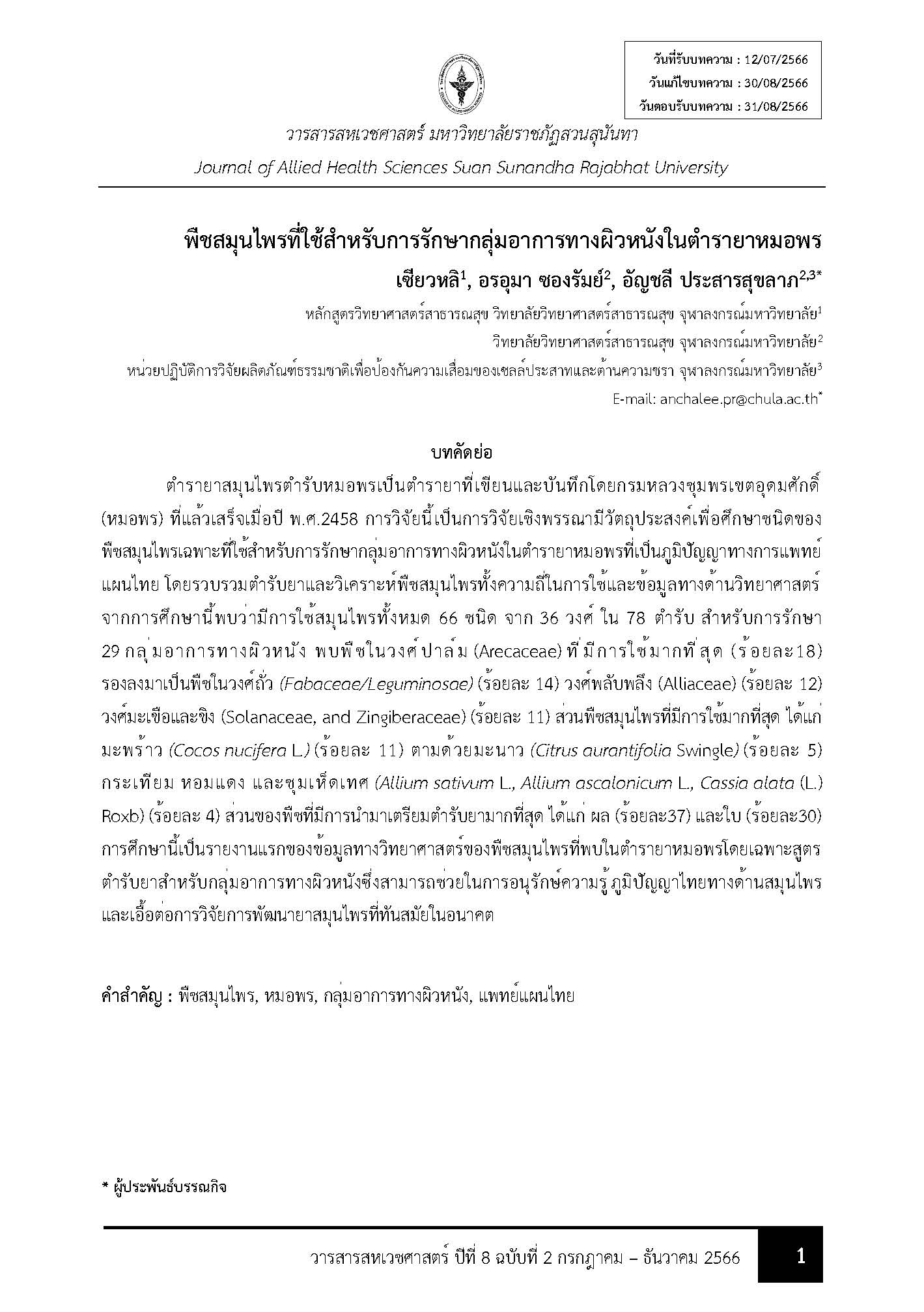Medicinal Plants Used For Treating Skin Conditions In Moh Phon’s Thai Herbal Formularies
Main Article Content
Abstract
Mor Phon's Thai herbal formularies were developed and recorded by His Royal Highness Prince Abhakara Kiartivongse, a royal son of King Rama V (Prince of Chumphon or Krom Luang Chumphon Khet Udomsak) until 1915. The purpose of this study was to elucidate traditional Thai medical wisdom regarding Mor Phon's Thai herbal formularies focus on skin conditions. Medicinal plants used for treating skin conditions in Mor Phon's Thai herbal formularies were compiled, authenticated and analyzed the frequency as well as reviewed on their scientific information. Sixty-six plant species from 36 families were mentioned in 78 different formulations for the treatment of 29 different skin conditions. The majority of the plant belong to the families of Arecaceae (18%), Fabaceae/Leguminosae (14%), Alliaceae (12%), Solanaceae (11%), and Zingiberaceae (11%). The most used plant species was Cocos nucifera L. (11%) followed by Citrus aurantifolia Swingle (5%), Allium sativum L., Allium ascalonicum L., Cassia alata (L.) Roxb (4%). Fruit (37%) and leave (30%) were the mostly used plant part to prepare the remedies. This study provides the first report on scientific information of plant materials used in Mor Phon's Thai herbal formularies for skin conditions which can help preserve the traditional medical knowledge and will facilitate future modern herbal drug development research.
Article Details
References
Khan MSA, Ahmad I. Herbal medicine: current trends and future prospects. New look to phytomedicine: Elsevier; 2019. p. 3-13.
Kennedy DA, Lupattelli A, Koren G, Nordeng H. Herbal medicine use in pregnancy: results of a multinational study. BMC Complement Altern Med. 2013; 13(1): 355. doi: 10.1186/1472-6882-13-355
Bahekar S, Kale R. Herbal plants used for the treatment of malaria-a literature review. Journal of pharmacognosy and Phytochemistry. 2013; 1(6): 141-6
Glover DD, Amonkar M, Rybeck BF, Tracy TS. Prescription, over-the-counter, and herbal medicine use in a rural, obstetric population. Am J Obstet Gynecol. 2003; 188(4):1039-45.doi: 10.1067/mob.2003.223
Sen S, Chakraborty R. Revival, modernization and integration of Indian traditional herbal medicine in clinical practice: Importance, challenges and future. J Tradit Complement Med. 2017; 7(2): 234-44. doi: 10.1016/j.jtcme. 2016.05.006
Dev S. Ancient-modern concordance in Ayurvedic plants: some examples. Environmental health perspectives. 1999; 107(10): 783-9
Afolayan AJ, Grierson DS, Mbeng WO. Ethnobotanical survey of medicinal plants used in the management of skin disorders among the Xhosa communities of the Amathole District, Eastern Cape, South Africa. Journal of ethnopharmacology. 2014; 153(1): 220-32
Development of moh phon’s diseases and herbal drugs database. 2021
J Mulholland, Thai traditional medicine: ancient thought and practice in a Thai context. 1979
Okoli R, Aigbe O, Ohaju-Obodo J, Mensah J. Medicinal herbs used for managing some common ailments among Esan people of Edo State, Nigeria. Pakistan Journal of Nutrition. 2007; 6(5): 490-6
Sharma HK, Chhangte L, Dolui AK. Traditional medicinal plants in Mizoram, India. Fitoterapia. 2001; 72(2): 146-61. doi: 10.1016/s0367-326x(00)00278-1
Jain R, Jain SK. Traditional medicinal plants as anticancer agents from Chhattishgarh, India: An overview. International Journal of Phytomedicine. 2010; 2(3):1
Purwanti E, Mahmudati N, Faradila S F, et al. Utilization of plants as traditional medicine for various diseases: Ethnobotany study in Sumenep, Indonesia[C]//AIP Conference Proceedings. AIP Publishing, 2020, 2231(1).
Van der Merwe D, Swan G E, Botha C J. Use of ethnoveterinary medicinal plants in cattle by Setswana-speaking people in the Madikwe area of the North West Province of South Africa[J]. Journal of the South African Veterinary Association, 2001, 72(4): 189-196.
Asase A, Kadera ML. Herbal medicines for child healthcare from Ghana. Journal of Herbal Medicine. 2014; 4(1): 24-36
Pham T L B, Thi T T, Nguyen H T T, et al. Anti-aging effects of a serum based on coconut oil combined with deer antler stem cell extract on a mouse model of skin aging[J]. Cells, 2022, 11(4): 597.
Shenefelt P D. Herbal treatment for dermatologic disorders[J]. 2012.
Abdel-Gelil O E A, Atwa N A, Moustafa A R A, et al. Alkanna species: a promising herbal medicine and its uses[J]. Journal of Food Science and Nutrition Research, 2019, 2(4): 309-315.
Parvaiz M, Hussain K, Khalid S, et al. A review: Medicinal importance of Glycyrrhiza glabra L.(Fabaceae family)[J]. Global J Pharmacol, 2014, 8(1): 8-13.

